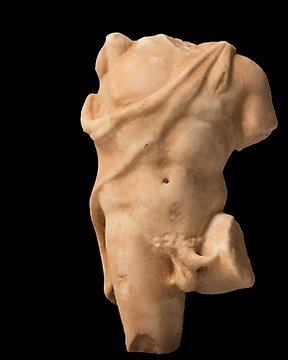
古罗马 大理石 萨蒂尔躯干。公元 1 至 2 世纪。高 14 厘米。动作非常优美
编号 85262301

编号 85262301

Torso of Venus pudica. Rome, 1st-2nd centuries A.D.
Marble.
Provenance:
-From 19th century European collection.
-Private collection, J.N. Los Angeles, USA. Inherited in 2021.
-USA Auction house 2022
Publications: -study report on the antiquity of the piece, issued by Dr. J. P. (name protected by Data Protection Law), professor of classical art, archaeology and history, associate professor in the Department of Art History at the University of Southern California, USA.
See report at the pictures.
Conservation: good condition, without restorations.
Measurements: 68,5 cm. height.
Roman marble sculpture representing a Venus Pudititia just out of the bath. The subtle cresting of the hips, the turgidity of the breasts and the roundness of the buttocks respond to a model of great technical exquisiteness. After Praxiteles created and installed in Cnidus the first plastic representation of a large female nude, other sculptors also made this theme their own. The complete nudity of the torso is due to the lack of arms that covered some parts of the body. This absence of upper extremities gives the sculpture a different aspect to the one it would have in origin. As a reference of such important iconography there is a statue preserved in its entirety in the Medici villa in Rome, which shows that the goddess covered her pubis with her left hand, while her right arm was raised to partially cover her breasts. The head, turned sharply to her left shoulder, was relatively small and the neck long, her hair was tied back on top of her head and a bun on top of the nape of her neck. The Medici Venus owes much to the Capitoline Venus, of ca. 280 B.C., but modifies it according to the stylistic principles of her own time, e.g., hips and shoulders and narrowing the waist.
The Romans brought two important novelties to the world of sculpture: portraiture and historical relief, neither of which existed in the Greek world. However, they followed the Greek models for a large part of their sculptural production, a base that in Rome was combined with the Etruscan tradition. After the first contacts with the Greece of classicism through the colonies of Magna Graecia, the Romans conquered Syracuse in 212 BC, a rich and important Greek colony located in Sicily, adorned with a large number of Hellenistic works. The city was sacked and its artistic treasures taken to Rome, where the new style of these works soon replaced the Etruscan-Roman tradition that had prevailed until then. Shortly afterwards, in 133 B.C., the Empire inherited the kingdom of Pergamon, where there was an original and thriving school of Hellenistic sculpture. The huge Pergamon Altar, the "Gallus committing suicide" or the dramatic group "Laocoön and his sons" were three of the key creations of this Hellenistic school. On the other hand, after Greece was conquered in 146 B.C. most Greek artists settled in Rome, and many of them devoted themselves to making copies of Greek sculptures, very fashionable at that time in the capital of the Empire. Thus, numerous copies of Praxiteles, Lysippus and classical works of the 5th century B.C. were produced, giving rise to the Neo-Attic school of Rome, the first neoclassical movement in the History of Art. However, between the end of the 2nd century BC and the beginning of the 1st century BC there was a change in this purist Greek trend, which culminated in the creation of a national school of sculpture in Rome, from which emerged works such as the Altar of Aenobarbus, which already introduced a typically Roman narrative concept, which would become a chronicle of daily life and, at the same time, of the success of its political model. This school will be the precursor of the great imperial art of Augustus, in whose mandate Rome became the most influential city of the Empire and also the new center of Hellenistic culture, as Pergamon and Alexandria had been before, attracting a large number of Greek artists and craftsmen. In the Augustan era Rome contributed to the continuity and renewal of a tradition that already had a centuries-old prestige, and which had dictated the character of all the art of the area.
Notes:
The seller guarantees that he acquired this piece according to all national and international laws related to the ownership of cultural property. Provenance statement seen by Catawiki.
The piece includes authenticity certificate.
The piece includes Spanish Export License (Passport for European Union) - If the piece is destined outside the European Union a substitution of the export permit should be requested.
#masterpieces